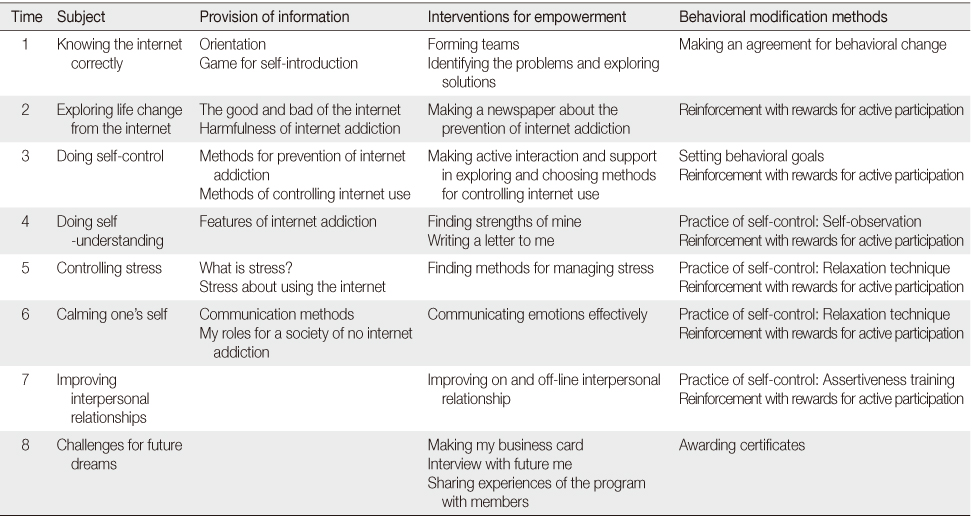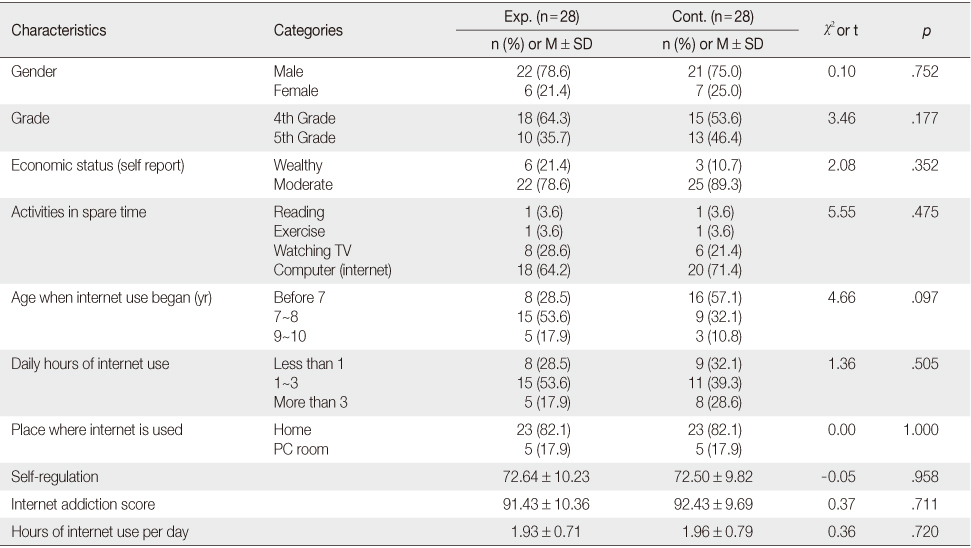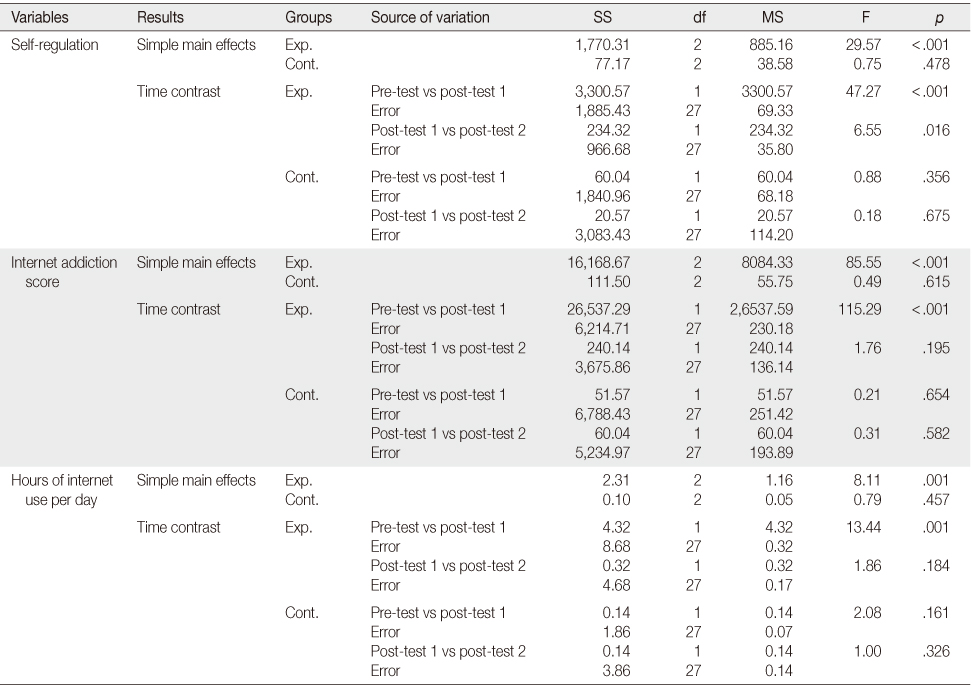Articles
- Page Path
- HOME > J Korean Acad Nurs > Volume 45(2); 2015 > Article
-
Original Article
- Effects of an Integrated Internet Addiction Prevention Program on Elementary Students' Self-regulation and Internet Addiction
- So Youn Mun, Byoung Sook Lee
-
Journal of Korean Academy of Nursing 2015;45(2):251-261.
DOI: https://doi.org/10.4040/jkan.2015.45.2.251
Published online: April 30, 2015
1Acheon Elementary School, Gimcheon, Korea.
2College of Nursing, Keimyung University, Daegu, Korea.
- Address reprint requests to: Lee, Byoung Sook. College of Nursing, Keimyung University, 1095 Dalgubul-daero, Dalseo-gu, Daegu 704-701, Korea. Tel: +82-53-580-3900, Fax: +82-53-580-3916, lbs@gw.kmu.ac.kr
© 2015 Korean Society of Nursing Science
This is an Open Access article distributed under the terms of the Creative Commons Attribution NoDerivs License. (http://creativecommons.org/licenses/by-nd/4.0/) If the original work is properly cited and retained without any modification or reproduction, it can be used and re-distributed in any format and medium.
Abstract
-
Purpose
- The purpose of this study was to develop an integrated internet addiction prevention program and test its effects on the self-regulation and internet addiction of elementary students who are at risk for internet addiction.
-
Methods
- A quasi-experimental study with a nonequivalent control group pretest-posttest design was used. Participants were assigned to the experimental group (n=28) or control group (n=28). Contents of the program developed in this study included provision of information about internet addiction, interventions for empowerment and methods of behavioral modification. A pre-test and two post-tests were done to identify the effects of the program and their continuity. Effects were testified using Repeated measures ANOVA, simple effect analysis, and Time Contrast.
-
Results
- The self-regulation of the experimental group after the program was significantly higher than the control group. The score for internet addiction self-diagnosis and the internet use time in the experimental group were significantly lower than the control group.
-
Conclusion
- The effects of the integrated internet addiction prevention program for preventing internet addiction in elementary students at risk for internet addiction were validated.
- 1. Korea Internet Addiction Center. 2010 internet addiction survey [Internet]. Seoul, Author. 2011;cited 2011 March 23. Available from: http://www.iapc.or.kr/info/lib/showInfoLibDetail.do?article_id=ICCART_0000000001500&board_type_cd=C1&searchCondition=&searchKeyword=
- 2. Ministry of Public Administration and Security. 2011 internet addiction survey [Internet]. Seoul, Author. 2011;cited 2012 June 14. Available from: http://www.mospa.go.kr/gpms/ns/mogaha/user/nolayout/main/nationDisplay.action
- 3. Young KS. Internet addiction: The emergence of a new clinical disorder. Cyberpsychol Behav. 2009;1(3):237–244. Article
- 4. Korea Agency for Digital Opportunity and Promotion. 2006 internet addiction survey [Internet]. Seoul, Author. 2006;cited 2007 March 19. Available from: http://www.iapc.or.kr/info/lib/showInfoLibDetail.do?article_id=ICCART_0000000000127&board_type_cd=C1&searchCondition=&searchKeyword=
- 5. Park YH. A study of the relationship between the internet use and the interpersonal relationships in the case of higher level pupils in a primary school [master's thesis]. Seoul, Yonsei University. 2002.
- 6. Cao F, Su L. Internet addiction among Chinese adolescents: Prevalence and psychological features. Child Care Health Dev. 2007;33(3):275–281. ArticlePubMed
- 7. Whang LS, Lee S, Chang G. Internet over-users' psychological profiles: A behavior sampling analysis on internet addiction. Cyberpsychol Behav. 2003;6(2):143–150. ArticlePubMed
- 8. Armstrong L, Phillips JG, Saling LL. Potential determinants of heavier internet usage. Int J Hum Comput Stud. 2000;53(4):537–550. Article
- 9. Ju SJ. Internet addiction and psychological factors in early adolescents. J Korean Acad Psychiatr Ment Health Nurs. 2008;17(1):46–54.ArticlePDF
- 10. Jeong TG. The effects of internet addiction and self control on achievement of elementary school children. J Yeolin Educ. 2005;13(1):143–163.
- 11. Tsai CC, Lin SS. Internet addiction of adolescents in Taiwan: An interview study. Cyberpsychol Behav. 2003;6(6):649–652. ArticlePubMed
- 12. Shin JS, Lee CH. The effects of self-control and social support on the adolescents' internet addiction. Korean J Youth Stud. 2010;17(8):105–128.
- 13. Joo A, Park I. Effects of an empowerment education program in the prevention of internet games addiction in middle school students. J Korean Acad Nurs. 2010;40(2):255–263. ArticlePubMed
- 14. Kim BG, Lee SJ, Koh YS, Cho SC, Hur IB, Ko SJ, et al. Internet addiction prevention education program in elementary school. Seoul: National Information Society Agency; 2007.
- 15. Yang MH. Behavioral support based on the theory of behavior modification. Seoul: Hakjisa; 2012.
- 16. Kwon HK, Kwon JH. The effect of the cognitive-behaviora1 group therapy for high risk students of internet addiction. Korean J Clin Psychol. 2002;21(3):503–514.
- 17. Moon SH. A study on the effects of integrative self-management program for internet-addiction prevention in elementary-school students [master's thesis]. Daegu, Daegu University. 2005.
- 18. Lee YS, Lee SJ, Do JY, Kim DI. Development of prevention program for youth excessive use of internet. Korean J Youth Couns. 2011;19(2):105–124.Article
- 19. Oh I, Kim C. Meta-analysis on the effects of the prevention and intervention programs for internet addiction. J Korean Inf Educ. 2009;13(4):529–537.
- 20. Griffiths M. The psychology of addictive behavior. London, UK: Harper Collins; 2009.
- 21. Kendall PC, Wilcox LE. Self-control in children: Development of a rating scale. J Consult Clin Psychol. 1979;47(6):1020–1029.ArticlePubMed
- 22. Kwon HJ. Relationship between child perceived level of maltreatment, self-control and anger expressions [master's thesis]. Seoul, Sookmyung Women's University. 2007.
- 23. Lee EO, Lim NY, Park HA, Lee IS, Kim JI, Bae J, et al. Nursing research and statistical analysis. Paju: Soomoonsa; 2009.
- 24. Kim CT, Kim D, Park JK, Lee SJ. Development of Korean internet addiction diagnostic scale. Seoul: National IT Industry Promotion Agency; 2002.
- 25. Lee HC, Ahn CY. A study on the development and effectiveness of cognitive-behavioral therapy for internet game addiction. Korean J Health Psychol. 2002;7(3):463–486.
- 26. Lee SJ. Behavior modification. Paju: Kyoyookbook; 2004.
- 27. Park GR, Kim HS. Effects of a group counseling integration program on self-determination and internet addiction in high school students with tendency to internet addiction. J Korean Acad Nurs. 2011;41(5):694–703. ArticlePubMed
- 28. Logue AW. Self-control: Waiting until tomorrow for what you want today. Englewood Cliffs, NJ: Prentice-Hall; 1995.
- 29. Kim HO, Kim SH. The effect of the reality therapy group counseling program on the improvement of self-esteem, internal control, and addictive internet use of the internet-addicted elementary school students. J Educ Res Mokpo Natl Univ. 2006;18(1):11–22.
- 30. Lee KS, Jung SJ, Kim MS, Seo BK. Development and effectiveness of internet addiction counseling program for upper grade elementary school children. Korean J Dev Psychol. 2013;26(1):231–253.
REFERENCES
Figure & Data
REFERENCES
Citations

- An Integrative Review of Interventions for Preventing Internet and Smartphone Addiction in Elementary School Students: Based on the IMB Model
Hyemin Park, Bohye Kim, Jaehee Jeong, Hwa Jeong Kim, Yebin Kim
STRESS.2024; 32(3): 133. CrossRef - Treatment effects of therapeutic interventions for gaming disorder: A systematic review and meta-analysis
Paul A. Danielsen, Rune A. Mentzoni, Torstein Låg
Addictive Behaviors.2024; 149: 107887. CrossRef - Effectiveness of a web-based group intervention for internet addiction in university students
Andreas Brouzos, Aikaterini Papadopoulou, Vasiliki C. Baourda
Psychiatry Research.2024; 336: 115883. CrossRef - The effect of gamification-based training on the knowledge, attitudes, and academic achievement of male adolescents in preventing substance and internet addiction
Esmaeel Taghipour, Fatemeh Vizeshfar, Nahid Zarifsanaiey
BMC Medical Education.2023;[Epub] CrossRef - Teknoloji Bağımlılığını Önlemeye Yönelik Psikoeğitim Programının 8. Sınıf Öğrencileri Üzerindeki Etkisi
Yunus Emre Karadağ, Cemal Onur Noyan
Bağımlılık Dergisi.2023; 24(1): 43. CrossRef - The effects of mobile phone use on students’ emotional-behavioural functioning, and academic and social competencies
Hossein Eskandari, Mohammad Reza Vahdani Asadi, Rouhollah Khodabandelou
Educational Psychology in Practice.2023; 39(1): 38. CrossRef - Health-policy approaches for problematic Internet use: lessons from substance use disorders
Dan J Stein, Anna Hartford
Current Opinion in Behavioral Sciences.2022; 46: 101151. CrossRef - Effects of Life Skill Training on the School Violence Attitudes and Behavior Among Elementary School Children
Jae Yeon Lee, Ok Kyung Ham, Hyun Soo Oh, Eun Jin Lee, Young Ko, Bongjeong Kim
The Journal of School Nursing.2022; 38(4): 336. CrossRef - Prevention Strategies to Address Problematic Gaming: An Evaluation of Strategy Support Among Habitual and Problem Gamers
Matthew W. R. Stevens, Paul H. Delfabbro, Daniel L. King
The Journal of Primary Prevention.2021; 42(2): 183. CrossRef - Prevention approaches to problem gaming: A large-scale qualitative investigation
Matthew W.R. Stevens, Paul H. Delfabbro, Daniel L. King
Computers in Human Behavior.2021; 115: 106611. CrossRef - The Effect of Mind Subtraction Meditation Intervention on Smartphone Addiction and the Psychological Wellbeing among Adolescents
Eun-Hi Choi, Min Young Chun, Insoo Lee, Yang-Gyeong Yoo, Min-Jae Kim
International Journal of Environmental Research and Public Health.2020; 17(9): 3263. CrossRef - Development and Effect of a Smartphone Overdependence Prevention Program for University Students Based on Self-Determination Theory
Myung Soon Kwon, Jeong Soon Yu
Journal of Korean Academy of Nursing.2020; 50(1): 116. CrossRef - Digital Nativity and Information Technology Addiction: Age cohort versus individual difference approaches
Hsin-Yi Wang, Leif Sigerson, Cecilia Cheng
Computers in Human Behavior.2019; 90: 1. CrossRef - LA PRÉVENTION DE L’UTILISATION PROBLÉMATIQUE D’INTERNET : EXPLORATION DU POINT DE VUE DES JEUNES
Gabrielle St-Arnaud, Magali Dufour1, Andrée-Anne Légaré, Joël Tremblay, Karine Bertrand, Yasser Khazaal, Natacha Brunelle, Mathieu Goyette
Revue québécoise de psychologie.2019; 40(2): 115. CrossRef - School-based Prevention for Adolescent Internet Addiction: Prevention is the Key. A Systematic Literature Review
Melina A. Throuvala, Mark D. Griffiths, Mike Rennoldson, Daria J. Kuss
Current Neuropharmacology.2019; 17(6): 507. CrossRef - Effects of a prevention intervention concerning screens, and video games in middle-school students: Influences on beliefs and use
Céline Bonnaire, Zéphyr Serehen, Olivier Phan
Journal of Behavioral Addictions.2019; 8(3): 537. CrossRef - Effects of a prevention program for internet addiction among middle school students in South Korea
Sun‐Yi Yang, Hee‐Soon Kim
Public Health Nursing.2018; 35(3): 246. CrossRef - Policy and Prevention Approaches for Disordered and Hazardous Gaming and Internet Use: an International Perspective
Daniel L. King, Paul H. Delfabbro, Young Yim Doh, Anise M. S. Wu, Daria J. Kuss, Ståle Pallesen, Rune Mentzoni, Natacha Carragher, Hiroshi Sakuma
Prevention Science.2018; 19(2): 233. CrossRef - Internet addiction detection rate among college students in the People’s Republic of China: a meta-analysis
Yao-jun Shao, Tong Zheng, Yan-qiu Wang, Ling Liu, Yan Chen, Ying-shui Yao
Child and Adolescent Psychiatry and Mental Health.2018;[Epub] CrossRef - Treatment and risk factors of Internet use disorders
Hideki Nakayama, Satoko Mihara, Susumu Higuchi
Psychiatry and Clinical Neurosciences.2017; 71(7): 492. CrossRef - Prevention and Policy Related to Internet Gaming Disorder
Daniel L. King, Paul H. Delfabbro
Current Addiction Reports.2017; 4(3): 284. CrossRef - Mediation Effects of Self regulation and Hopelessness between Self efficacy and Internet game addiction in Middle School Students
Bo Young Kim
Journal of Korean Public Health Nursing.2015; 29(3): 441. CrossRef
The Contents of the Integrated Internet Addiction Prevention Program
Homogeneity of the Participants
Exp.=Experimental group; Cont.=Control group.
Effect of the Internet-Addiction Prevention Program
Exp.=Experimental group; Cont.=Control group; G*T=Interaction between group and time.
Simple Main Effects and Time Contrast in Dependent Variables by Measurement Time
Exp.=Experimental group (n=28); Cont.=Control group (n=28); SS=Sum of square; MS=Mean square.
Exp.=Experimental group; Cont.=Control group.
Exp.=Experimental group; Cont.=Control group; G*T=Interaction between group and time.
Exp.=Experimental group (n=28); Cont.=Control group (n=28); SS=Sum of square; MS=Mean square.
 KSNS
KSNS
 E-SUBMISSION
E-SUBMISSION




 Cite
Cite

